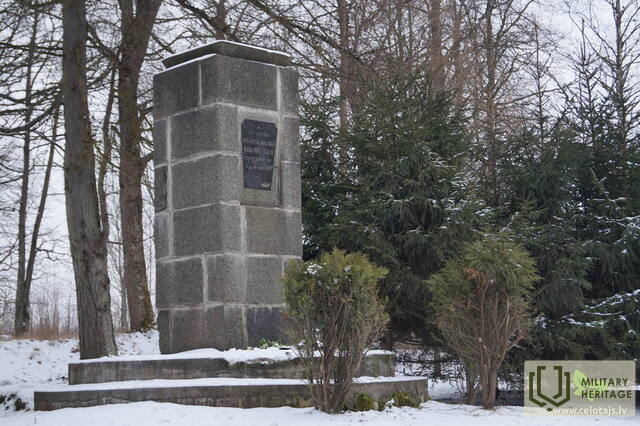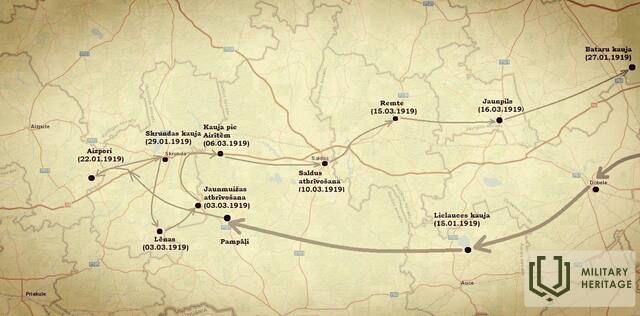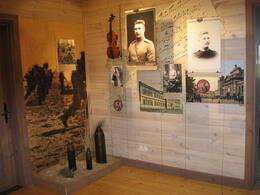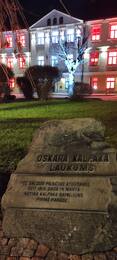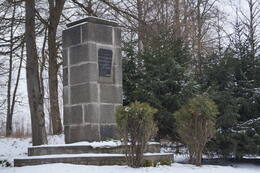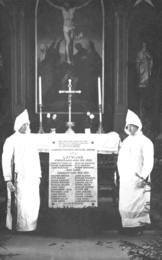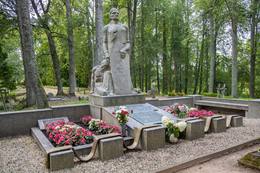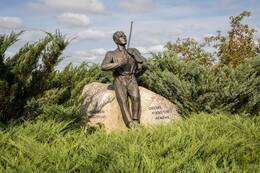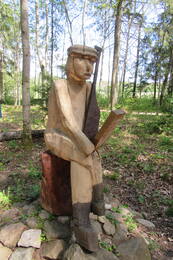Schlacht von Oskars Kalpaks Bataillon bei Lielauce
In der Nacht zum 15. Januar gewann das Kalpaka-Bataillon die erste Schlacht bei Lielauce und schlug den roten Angriff. Es war die erste bedeutende Schlacht des Kalpaka-Bataillons, als der Sieg den Soldaten einen besonders starken moralischen Impuls gab.
Das Kalpaka-Bataillon blieb 1919 nur drei Tage in Lielauce, aber diese Schlacht ist ein sehr wichtiger Moment in der Geschichte Lettlands geblieben. „Die Streitkräfte waren klein, ein Teil der lettischen Armee war ein Teil der deutschen Armee, als die Rote Armee mit einer riesigen Streitmacht in Lettland einmarschierte. Dank sorgfältiger Geheimdienstarbeit war dieser Kampf kurz, aber blutig, der nach Mitternacht begann und auf beiden Seiten Fehler machte - die "Roten", die das Licht des Kalpaks-Bataillons im 2. Stock sahen, konnten das Ziel des Angriffs identifizieren, aber zwei - weiter zu Dobele halb gelegt, bemerkten die Soldaten die Angreifer, obwohl es einen tiefen Schneesturm gab und die Raketenkanone nicht funktionierte, wegliefen und richtig warnten, hatte die Schlacht keinen überraschenden Hintergrund. Als erster fiel Leutnant Pēteris Dambītis, weil er die Stiefel des Soldaten neben den Pfosten gelegt hatte, so dass er sie nicht anziehen konnte… das Wasser im Fass ist gefroren, es half auch, diese Schlacht zu gewinnen (..). Major Ilgvars Baumanis, der Chef des Veteranenverbandes der Lettischen Nationalgarde, erzählte bei der Gedenkfeier in Lielauce (~ 2015) von der ersten Schlacht von Kalpaks.
Auce Bezirk TIC, 30.09.2016
Zugehörige Objekte
Oskars-Kalpaks-Museum und Gedenkstätte „Airītes“
Das Oskars-Kalpaks-Museum und die Gedenkstätte „Airītes“ liegen zwischen Saldus und Skrunda, unweit der Fernstraße A9. Die Ausstellung bietet umfassende Informationen über Oberst Oskars Kalpaks, das von ihm kommandierte Bataillon und beleuchtet die Geschichte der nationalen Streitkräfte Lettlands sowie die Entstehung der Gedenkstätte „Airītes“. Vorgestellt wird Oberst Oskars Kalpaks als Mensch, als Soldat und als Kämpfer für die Unabhängigkeit Lettlands. Die Exponate werden durch Tonaufnahmen von Zeitzeugen ergänzt (Lettisch, Englisch und Deutsch). Sie unterstreichen die große Bedeutung der historischen Abläufe von 1918-1919 für die Durchsetzung der staatlichen Unabhängigkeit Lettlands. Das Museumsgebäude ist renoviert. Der Eintritt ist frei, Führungen sind kostenpflichtig.
Die Gedenkstätte verfügt über einen Picknickplatz, einen Park mit Hindernisparcours und einen Seminarraum für bis zu 30 Personen. Ferner werden verschiedene Workshops angeboten.
Gedenkstein auf dem Oskaras Kalpaka-Platz in Saldus
Der O.Kalpaka-Platz befindet sich im Zentrum von Saldus, an der Kreuzung der Straßen Lielā und Striķu.
Der ehemalige Marktplatz ist heute ein beliebter Erholungsort für Einwohner und Besucher von Saldus, wo Konzerte, Gedenkveranstaltungen und Feste stattfinden. Am 10. März 1919 wurde Saldus als erste lettische Stadt von Oberst Oskars Kalpaks' Bataillon befreit.
Am 14. März 1919 fand auf dem Platz die erste Parade des lettischen Separatistenbataillons statt, und 1992 wurde der Platz zu Ehren von Oberst Kalpakas nach ihm benannt.
Denkmal für die erste Schlacht von Oskars Kalpaks-Bataillon in Lielauce
Das Denkmal für die erste Schlacht des Oskars-Kalpaka-Batail lons befindet sich in der Nähe der Ruinen der lutherischen Kir che von Lielauce. Es wurde am Ort der Schlacht von Kalpaks Bataillon errichtet, die in der Nacht vom 15. zum 16. Januar 1919 stattfand. In der Schlacht schlugen zwei Kompanien von Kalpaks-Bataillon einen Angriff eines ganzen bolschewistischen Bataillons und einer Kavallerieschwadron zurück. Es war die erste wichtige Schlacht des Kalpaks-Bataillons. Da die Landeswehr die Schlacht in Auce verlor, wurde beschlossen, sich zurückzu ziehen und die Front an einem natürlichen Hindernis – dem Fluss Venta – zu halten.
Das Denkmal wurde am 19. August 1934 in Anwesenheit des ehemaligen Mitglieds von Kalpaks-Bataillon, Landwirtschaftsmi nister J. Kauliņš, eröffnet. Das Denkmal wurde vom Architekten P. Dreimanis entworfen und von J. Sieriņš hergestellt. Das Denkmal besteht aus grauen Granitblöcken, auf der Vorderseite befindet sich eine schwarze Granittafel mit Text: „Hier fand in der Nacht vom 15. zum 16. Januar 1919 die Schlacht des Bataillons von Oberst Kalpaks statt.“ Vier Soldaten wurden im Einsatz getötet. Das Denkmal wurde in den frühen 1950er Jahren zerstört und die Gedenktafel zertrümmert. Es wurde 1991 unter Verwendung des ursprünglichen Schildes, das in zwei Teile geteilt worden war, restauriert. Bei dem restaurierten Denkmal ist die Tafel nicht mehr auf die Kirche, sondern auf das Zentrum von Lielauce gerichtet.
Gedenktafeln für die im Ersten Weltkrieg und im Unabhängigkeitskrieg gefallenen Lubaner in der lutherischen Kirche von Lubana
Befindet sich in Lubāna, Baznīcas-Straße 1, lutherische Kirche.
In der Zwischenkriegszeit wurde in der Kirche von Lubāna eine Gedenktafel aus weißem Marmor für Oberst Oskars Kalpaks aufgestellt. „geboren Hugo Celmins.
Materialien über Oskars Kalpaks und Hugo Celmiņš sind täglich in der Ausstellung des Kulturerbe- und Tourismusinformationszentrums Lubāna zu sehen.
Die letzte Ruhestätte von Oberst Oskars Kalpaks
Das Hotel liegt auf dem Visagala-Friedhof im Stadtteil Madona
Am 10. Juli 1927 wurde Oskars Kalpaks ein Denkmal von Kārlis Zāle und Arnolds Dzirkaļs enthüllt – eine Komposition aus drei Figuren, in deren Mitte sich ein alter lettischer Krieger mit einem Schild und einem Schwert in der Hand befindet, aber auf beiden Seiten ist ein schwingender Soldat. Am Fuß der Skulpturengruppe ist schräg auf einem Granitsockel eine Bronzetafel angebracht, auf der ein Text eingraviert ist, der auch ein Kalpak gewidmetes Gedicht von Edward Virza enthält.
Oskars Kalpaks fiel 1919. Am 6. März wurden seine sterblichen Überreste in der Nähe von "Airīte", am Rande der Straße Skrunda - Saldus, am 18. September vom nördlichen Friedhof von Liepāja auf den Familienfriedhof in Visagala überführt.
Das Denkmal wurde von General J. Balodis, dem Vorsitzenden des Denkmalkomitees von Oberst O. Kalpaks, unter Beteiligung des damaligen Präsidenten G. Zemgale, des Ministerpräsidenten M. Skujenieks, des Sprechers der Saeima P. Kalniņš, des Kriegsministers R Bangerskim und K. Ulmanis. Der Grundstein des Denkmals wurde am 19. Juni 1925 gelegt. Der Stein für das Denkmal stammt aus dem Geburtshaus des Obersten im Sumpf von Siena, O. Kalpaks spielte als Kind gerne auf diesem Stein Geige.
Heimathof „Liepsalas“ von Oberst Oskars Kalpaks und seine Grabstätte auf dem Friedhof Visagals
Die Erinnerungsstätte am Geburtshaus „Liepsalās“ von Oberst Oskars Kalpaks befindet sich in der Gegend zwischen Madona und dem Lubāns-See. Die Gedenkstätte entstand 1997 nach den Vorstellungen und aus Mitteln der Nichte von Oberst Kalpaks, Ārija Kalpaks-Grundmane (1922-2006). Die Anlage besteht aus verschiedenen Naturobjekten und Steinskulpturen mit symbolischen Anspielungen auf die ethischen und patriotischen Werte der Letten. Im größten Gebäude entstand eine Ausstellung über die lettischen Freiheitskriege und die 22 Jahre der Freiheit in Lettland (1918-1940). Auf dem Friedhof von Visagals steht ein Denkmal für Oskars Kalpaks, das 1927 von Kārlis Zāle und Arnolds Dzirkalis geschaffen wurde. Es handelt sich um eine Komposition aus drei Figuren: einem altlettischen Krieger mit Schwert und Schild im Zentrum und jeweils einem niedergesunkenen Soldaten zu beiden Seiten. Am Fuße der Skulpturengruppe ist eine Bronzetafel auf einem geneigten Granitsockel angebracht, in die ein Text eingraviert ist, der ein Kalpaks´ gewidmetes Gedicht von Edvards Virza enthält. Oskars Kalpaks fiel am 6. März 1919 bei Airite, an der Verbindungsstraße zwischen Skrunda- und Saldus.
"Natur-Kraft-Pfad" des Oskars Kalpaks Museums
Der Lehrpfad wurde auf dem Gelände neben dem Museum angelegt und basiert auf der Idee der Gestaltung des O. Kalpaks-Museums und seiner Umgebung im Jahr 1936.
Auf dem Lehrpfad sind Holzskulpturen zu sehen, die im Rahmen eines von der Technischen Hochschule für Technologie und Tourismus Kuldīga organisierten Pleinair-Workshops zum Thema "Aus Liebe zur Freiheit" entstanden sind. Zu sehen sind auch großformatige Gemälde aus dem Pleinair-Kunstwerk "Schütze dein Vaterland", das von Schülerteams aus den umliegenden Regionen gemalt wurde.
Für die jüngsten Besucher des Museums wurde im Naturlehrpfad ein Mini-Airtrack eingerichtet.
Schloss Lielauce und die erste Schlacht des Bataillons von Oskar Kalpak
Das Herrenhaus Lielauce mit dem Park ist ein Objekt, das in der Geschichte Lettlands mit der ersten Schlacht und dem ersten Sieg von Kalpak im Januar 1919 während des Unabhängigkeitskrieges verbunden ist. Das heutige Gebäudeensemble des Gutshofes entstand im Wesentlichen im 19. Jahrhundert. am Anfang. Das Herrenhaus wurde ursprünglich im Empire-Stil als zweistöckiges Gebäude mit Ziegeldach erbaut. Die Nebengebäude der Anlage liegen weiter vom Herrenhaus entfernt am Rande des Parks. Darin sind das Haus des Verwalters, das später zum Kulturhaus umgebaut wurde, Stallungen, ein Gesindehaus und ein Eiskeller am Teichufer erhalten geblieben. Nur die Fundamente des 1801 erbauten Getreidespeichers sind erhalten geblieben, aber die Volumina der Kegelmühle sind trotz Wiederaufbau gut erhalten geblieben. Ebenso können das Steuerhaus oder die Kutschenscheune des Herrenhauses noch besichtigt werden.
Nach der Gründung des lettischen Staates wurde zunächst das Gebäude des Gutshofs Lielauce mit angrenzendem See, Park, Gebäuden und einem bestimmten Waldgebiet für die Errichtung eines Waisenhauses übergeben, das jedoch nicht errichtet wurde. Im November 1926 übernahm die Abteilung für Forstwirtschaft der Landwirtschaftsfakultät der Universität Lettland den Lielauce-Palast, der ihr vom Zentralen Landkomitee für die Organisation von Ausbildungspraktiken zur Verfügung gestellt wurde, mit eigenem Park und 59 ha Land. Nach dem Zweiten Weltkrieg befand sich hier bis 2009 die Grundschule Lielauce, gleichzeitig war es aber auch das LLU-Servicehotel. Derzeit sind das Herrenhaus und der Park Eigentum der SIA „Mudia“. Bis der technische Zustand des Herrenhauses verbessert ist, ist es für Besucher nicht zugänglich.
In der Nacht des 15. Januar 1919 gewann das Kalpak-Bataillon die erste Schlacht bei Lielauce und wehrte den Angriff der Roten ab. Es war die erste wichtige Schlacht des Kalpak-Bataillons, bei der der Sieg den Soldaten einen besonders starken moralischen Auftrieb verlieh.
Während des Rückzugs erreichte das separate Bataillon der Letten am 12. Januar das Schloss des Herrenhauses Lielauce, ließ sich dort zur Ruhe nieder und postierte Wachposten auf den umliegenden Straßen. Am frühen Morgen des 16. Januar bemerkten die Wachen den Feind, der sich über die Dobele-Autobahn näherte, und es gelang ihnen, die Bewohner des Palastes zu warnen. Die erste, die in die Schlacht eintrat, war die Reserve-Offizierskompanie, die in der Nähe des Herrenhauses Stellung bezogen hatte. Die in zwei Teile geteilte Kompanie von Cēsis versuchte, den Gegner zu umzingeln. Zunächst zogen sich die Riesen zurück, starteten dann aber einen Gegenangriff, den die Firma Cēsis jedoch abwehren konnte. Der Gegner musste sich zurückziehen. Der erste Sieg gegen die Giganten war errungen. Obwohl es auf der Seite der Kalpakianer vier Gefallene gab (Leutnant Kārlis Dambītis, Leutnant Fridrihs Liepa, Militärbeamter Vilis Cīrulis und Ausbilder Jānis Būvmeistars) und acht Verwundete, weckte das Ergebnis der Schlacht den Wunsch der Soldaten, den Kampf gegen den Feind fortzusetzen . Leider musste das lettische Einzelbataillon bereits am selben Tag seine Stellungen verlassen, da die deutsche Raden-Kompanie, die sich zurückzog, die Schlacht bei Vecauce verlor.




